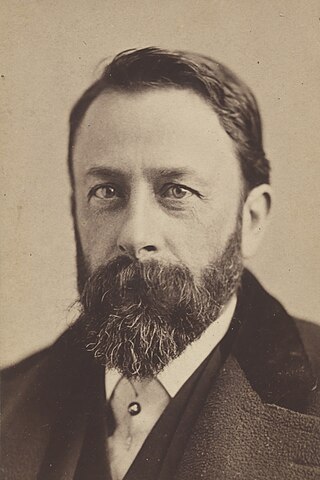
Albert Bierstadt was a German American painter best known for his lavish, sweeping landscapes of the American West. He joined several journeys of the Westward Expansion to paint the scenes. He was not the first artist to record the sites, but he was the foremost painter of them for the remainder of the 19th century.

Mount Bierstadt is a 14,065-foot-high (4,287 m) mountain summit in the Front Range of the Rocky Mountains, in the U.S. state of Colorado. The fourteener is located in the Mount Evans Wilderness of Pike National Forest, 9.4 miles (15.1 km) south by east of the Town of Georgetown in Clear Creek County. It was named in honor of Albert Bierstadt, an American landscape painter who made the first recorded summit of the mountain in 1863.
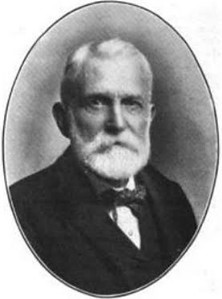
Edward Bierstadt was a photographer of portraits and landscapes as well as an engraver and a pioneer of color photography in the United States.

In 1859 Albert Bierstadt accompanied Frederick W. Lander on a western expedition. On his return he painted a mountain landscape on a large 6-by-10-foot (1.8-by-3.0-meter) canvas, The Rocky Mountains, Lander's Peak. Following the death of General Lander during the Civil War in 1862, Bierstadt named the peak Lander's Peak. The painting was completed in 1863 and sold in 1865 for $25,000.

The Rocky Mountains, Lander's Peak is an 1863 landscape oil painting by the German-American painter Albert Bierstadt. It is based on sketches made during Bierstadt's travels with Frederick W. Lander's Honey Road Survey Party in 1859. The painting shows Lander's Peak in the Wyoming Range of the Rocky Mountains, with an encampment of Native Americans in the foreground. It has been compared to, and exhibited with, The Heart of the Andes by Frederic Edwin Church. Lander's Peak immediately became a critical and popular success and sold in 1865 for $25,000.

Looking Down the Yosemite Valley, California is an 1865 painting by the German-American painter Albert Bierstadt (1830–1902).

The Rocky Mountains is an 1866 oil-on-canvas landscape painting by the German-American painter Albert Bierstadt, a painter of Westward Expansion scenes in the latter 19th century.
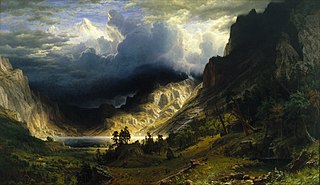
A Storm in the Rocky Mountains, Mt. Rosalie is an 1866 landscape oil painting by German-American painter Albert Bierstadt (1830–1902) which was inspired by sketches created on an 1863 expedition.

Bierstadt Lake is located in Larimer County, Colorado and within the Rocky Mountain National Park. Near McHenrys Peak and Longs Peak, there are "spectacular views" of the Continental Divide at the lake. The Bierstadt Lake Trailhead is located about 6.5 miles (10.5 km) from the turn-off at U.S. Route 36 into the Rocky Mountain National Park. During the summer, shuttle buses provide transportation to the trailhead.

Mount Hood is an 1869 painting by the German-American painter Albert Bierstadt, and part of the collection of the Portland Art Museum in Portland, Oregon, in the United States. It portrays a view of the mountain in Oregon with the same name.

Valley of the Yosemite is a painting by the German American painter Albert Bierstadt that was completed in 1864. Initially associated with the Hudson River School, Bierstadt rose to prominence for his paintings of the Rocky Mountains, which established him as one of the best painters of the western American landscape. His later paintings of Yosemite were also received with critical acclaim and public praise.

Alaskan Coast Range is an 1889 landscape painting by the German American painterAlbert Bierstadt that presently hangs in the Smithsonian American Art Museum. While traveling through British Columbia, Bierstadt took a steamship to Alaska in search of more rugged landscapes. He ended up shipwrecked in Loring, Alaska. While sheltering in a nearby Native American settlement, he drew his littoral Alaskan surroundings; this work is most likely an oil sketch made for further detailing.

On the Platte River, Nebraska is an 1863 oil landscape painting by the Hudson River School artist Albert Bierstadt.

The Falls of St. Anthony is an 1880 oil landscape painting by the Hudson River School artist Albert Bierstadt.

California Spring is an 1875 oil landscape painting by the Hudson River School artist Albert Bierstadt. The painting is based on sketches of the Sacramento River Valley, made by Bierstadt when he visited the region in the early 1870s.
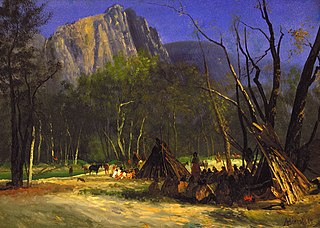
Indians in Council, California is an 1872 oil landscape painting by the Hudson River School artist Albert Bierstadt. The painting was made amidst Bierstadt's Yosemite and Sierra Nevada work, while he was residing in California. He felt that Native American life was "rapidly passing away" and it was an artist's duty to "tell ... their history".

Puget Sound on the Pacific Coast is an 1870 oil landscape painting by the Hudson River School artist Albert Bierstadt. At the time of the work's completion, Bierstadt had not yet traveled to what was then Washington Territory. The work, commissioned by China trade merchant Abiel Abbot Low, was painted solely by written description of the Sound.
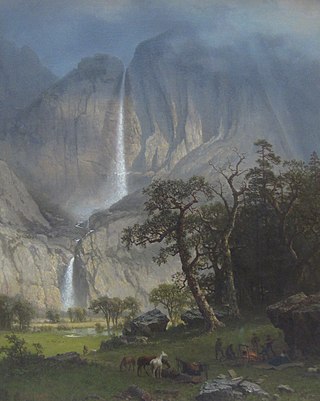
Cho-looke, the Yosemite Fall is an 1864 oil painting on canvas by the German American painter Albert Bierstadt.

Among the Sierra Nevada, California is an 1868 oil-on-canvas painting by German-American artist Albert Bierstadt which depicts a landscape scene of the Sierra Nevada mountain range in California. Created at his studio in Rome, the painting was exhibited throughout Europe, creating interest in immigration to the United States. Measuring 72 by 120+1⁄8 inches, the painting is a centerpiece of the 19th-century landscape collection at the Smithsonian American Art Museum in Washington, D.C.



















